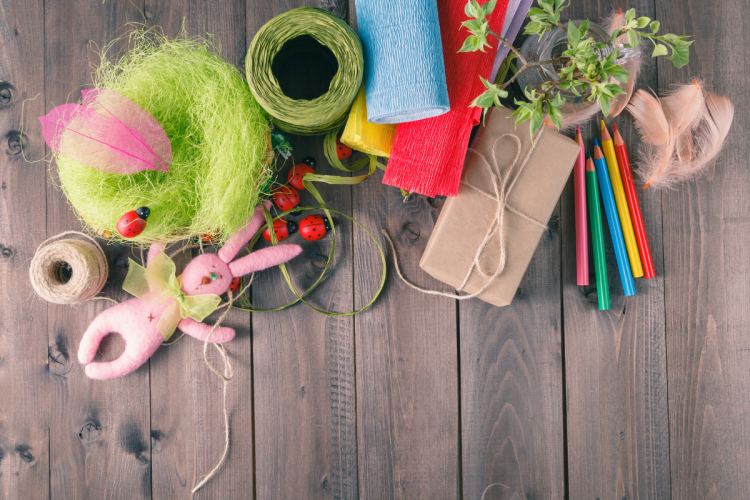Introduction to Eco-Friendly Crafting
Definition and Importance Eco-friendly crafting refers to the practice of creating art and craft projects in a manner that minimizes harm to the environment. This includes using sustainable materials, reducing waste, and employing techniques that have a lower ecological footprint. The importance of eco-friendly crafting is growing as awareness of environmental issues increases.
Recent Trends in Sustainable Crafting In recent years, there’s been a significant shift towards sustainable practices in the crafting world. Crafters are becoming more conscious of their material choices and the impact of their hobbies on the environment.
Understanding the Impact of Crafting on the Environment
The Environmental Footprint of Traditional Crafting Materials Traditional crafting materials can have a significant environmental impact, from the extraction of raw materials to the waste produced at the end of a product’s life cycle. Make sure you use an eco-friendly printer of die cut stickers, if you use them in crafting.
Case Studies: The Negative Impact of Non-Sustainable Crafting Several case studies highlight the negative impacts of non-sustainable crafting practices, emphasizing the need for change.
Essential Materials for Eco-Friendly Crafting
Sustainable and Recycled Materials Key to eco-friendly crafting is the use of sustainable and recycled materials. These can range from natural fibers to repurposed items.
Evaluating the Eco-Friendliness of Craft Supplies It’s crucial for crafters to learn how to evaluate the eco-friendliness of their supplies, considering factors like sourcing, production processes, and biodegradability.
Techniques and Methods for Sustainable Crafting
Upcycling and Repurposing in Crafting Upcycling and repurposing old items into new crafts are fundamental techniques in sustainable crafting, offering creative and environmental benefits.
Low-Waste Crafting Techniques Low-waste techniques focus on reducing the amount of waste produced during the crafting process, including efficient material use and waste repurposing.
Eco-Friendly Crafting in Different Domains
Textiles and Fabrics In textile crafting, eco-friendly practices include using organic or recycled fabrics and natural dyes.
Paper and Stationery For paper crafts, using recycled paper or paper from sustainable sources is key, along with minimizing paper waste.
Beading and Jewelry Making In beading and jewelry making, eco-friendly practices involve using recycled materials and avoiding harmful chemicals.
Guidelines for Reducing Waste in Crafting
Effective Use of Leftover Materials Tips and techniques for using leftover materials can significantly reduce waste in crafting projects.
Tips for Minimizing Crafting Waste Additional tips for minimizing waste include planning projects carefully and reusing tools and supplies wherever possible.
The Role of Digital Tools in Sustainable Crafting
Online Resources and Communities The internet offers a wealth of resources and communities focused on eco-friendly crafting, providing inspiration, tips, and support.
Digital Crafting Tools and Their Environmental Benefits Digital tools can play a significant role in reducing the environmental impact of crafting, from digital design software to online tutorials that minimize the need for physical resources.
Community and Collaboration in Eco-Friendly Crafting
Joining Eco-Crafting Communities Joining eco-crafting communities can provide support, inspiration, and shared resources for crafters looking to adopt more sustainable practices.
Collaborative Projects and Initiatives Collaborative projects and initiatives often emerge within these communities, driving forward the movement for sustainable crafting.
Eco-Friendly Crafting for Children and Education
Teaching Sustainable Practices to Young Crafters Educating the next generation of crafters about sustainable practices is crucial for the future of eco-friendly crafting.
Crafting Projects for Schools and Educational Settings Schools and other educational settings can integrate eco-friendly crafting into their curricula, teaching children the importance of sustainability.
Challenges and Solutions in Eco-Friendly Crafting
Overcoming Common Obstacles Crafters often face challenges in transitioning to eco-friendly practices, but there are numerous solutions and workarounds available.
Innovative Solutions in Sustainable Crafting Innovation is key in sustainable crafting, with new materials and techniques constantly being developed.
Showcasing Eco-Friendly Crafting Projects
Case Studies of Successful Sustainable Crafting Projects Showcasing successful projects can inspire others and demonstrate the potential of eco-friendly crafting.
Inspiration from Eco-Crafters Worldwide Drawing inspiration from crafters around the world can provide new ideas and perspectives on sustainable crafting.
The Future of Eco-Friendly Crafting
Emerging Trends and Innovations The future of eco-friendly crafting looks bright, with new trends and innovations constantly emerging.
Predictions for Sustainable Crafting Practices Predictions for the future of sustainable crafting suggest a continued shift towards more environmentally responsible practices.
How to Get Started with Eco-Friendly Crafting
First Steps for Beginners For those new to eco-friendly crafting, starting can be as simple as choosing one sustainable practice to incorporate into their craft.
Resources and Guides for Starting There are numerous resources and guides available for beginners, offering step-by-step instructions and tips.
Conclusion: The Importance of Sustainable Crafting
Summary of Key Points The article concludes by summarizing the key points covered and reinforcing the importance of sustainable crafting practices.
Encouragement for Sustainable Crafting Practices Crafters are encouraged to continue exploring and implementing eco-friendly practices in their crafting endeavors.
